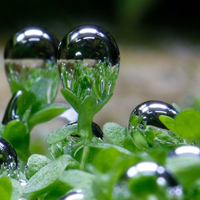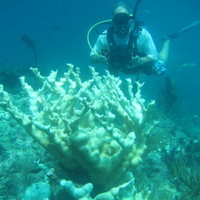Login
Subscribecorals

Corals and Sea Anemones Turn Sunscreen into Toxins—Understanding How Could Help Save Coral Reefs
Djordje Vuckovic and Bill Mitch, The Conversation | May 6, 2022 | 6 min read
Researchers have long suspected that an ingredient in sunscreen called oxybenzone was harming corals, but no one knew how. A new study shows how corals turn oxybenzone into a sunlight-activated toxin.

Infographic: How Corals Remember the Past, Prepare for the Future
Amanda Heidt | Feb 14, 2022 | 1 min read
Scientists have documented examples of corals “remembering” prior exposure to heat stress in the field, and are now simulating these phenomena in the lab to better understand their cellular and molecular underpinnings.

Our Favorite Cell and Molecular Biology Stories of 2021
Jef Akst | Dec 2, 2021 | 3 min read
Beyond The Scientist’s coverage of COVID-19’s molecular underpinnings were many other stories highlighting the advances made in scientists’ understanding of the biology of cells.

First Immortal Cell Line Cultured for Reef-Building Corals
Amanda Heidt | Jul 1, 2021 | 3 min read
Lab-grown cells from the reef-building coral Acropora tenuis provide new opportunities to study bleaching, symbioses, and biomineralization.

Infographic: How Scientists Are Creating Coral Cell Lines
Amanda Heidt | Jul 1, 2021 | 1 min read
Stable, long-term cell lines will enable scientists to study everything from coral bleaching to biomineralization, knowledge that may help protect corals from ongoing climate change.

Comprehensive Atlas of Reef-Building Coral’s Cells Created
Christie Wilcox, PhD | May 13, 2021 | 5 min read
Single-cell RNA sequencing helps to catalog the dozens of cell types present in a stony coral, including its elusive immune cells.

Certain Color Varieties of a Coral Are More Protected from Bleaching
Lisa Winter | Feb 25, 2021 | 2 min read
In yellow-green and purple versions of the reef-building Acropora tenuis, the genes that code for particular fluorescent and other colorful proteins become more active in the summer, protecting symbiotic algae from thermal stress and resisting bleaching.

Q&A: Parachute Science in Coral Reef Research
Asher Jones | Feb 24, 2021 | 8 min read
Scientists who study the marine ecosystems have frequently failed to involve local researchers in projects, a study finds.

Slideshow: Restoring Coral Reefs
Hanna R. Koch, Erinn Muller, and Michael P. Crosby | Feb 1, 2021 | 2 min read
By growing mountainous star corals in the lab and outplanting them to dying reefs, we were able to grow sexually mature corals that could help reef recovery.

Restored Corals Spawn Hope for Reefs Worldwide
Hanna R. Koch, Erinn Muller, and Michael P. Crosby | Feb 1, 2021 | 10+ min read
Novel technologies establish a new paradigm for global coral reef restoration, with in situ spawning of mature, environmentally resilient corals in five years instead of decades.

Infographic: How to Accelerate the Growth of Restored Corals
Hanna R. Koch, Erinn Muller, and Michael P. Crosby | Feb 1, 2021 | 2 min read
Our novel technique involves planting several small fragments of slow-growing corals onto dead coral heads. The fragments eventually fuse, forming a large colony in a fraction of the time that it takes wild corals to build reefs.

Image of the Day: Symbiotic Algae
Emily Makowski | Jan 13, 2020 | 1 min read
Anemones keep their algae populations in check.

Photos of the Year
Emily Makowski | Dec 26, 2019 | 2 min read
From bubbling plants to endangered whales, here are some amazing images from The Scientist in 2019.

Image of the Day: Microscopic Creatures
Emily Makowski | Dec 12, 2019 | 1 min read
View the top three winners of this year’s Nikon Small World in Motion Competition.

Image of the Day: Coral Disease
Emily Makowski | Oct 7, 2019 | 1 min read
A mysterious illness is causing tissue loss in many species.

Image of the Day: Stress-Resistant Corals
Emily Makowski | Sep 19, 2019 | 2 min read
Some corals can adjust to a range of temperatures, but this ability may be limited in a consistently warmer environment.

Image of the Day: Synchronous Spawning
Emily Makowski | Sep 9, 2019 | 1 min read
Groups of corals release all of their eggs and sperm once a year, but the timing of their spawning is under threat from climate change.

Image of the Day: Cooperative Sponges
Nicoletta Lanese | Aug 15, 2019 | 1 min read
Mycale grandis teams up with microbes housed inside it to gather nutrients.

Coral Deaths Spurred by Pollutants From Land
Nicoletta Lanese | Jul 17, 2019 | 2 min read
Runoff and waste may be more harmful to the animals than climate change.
